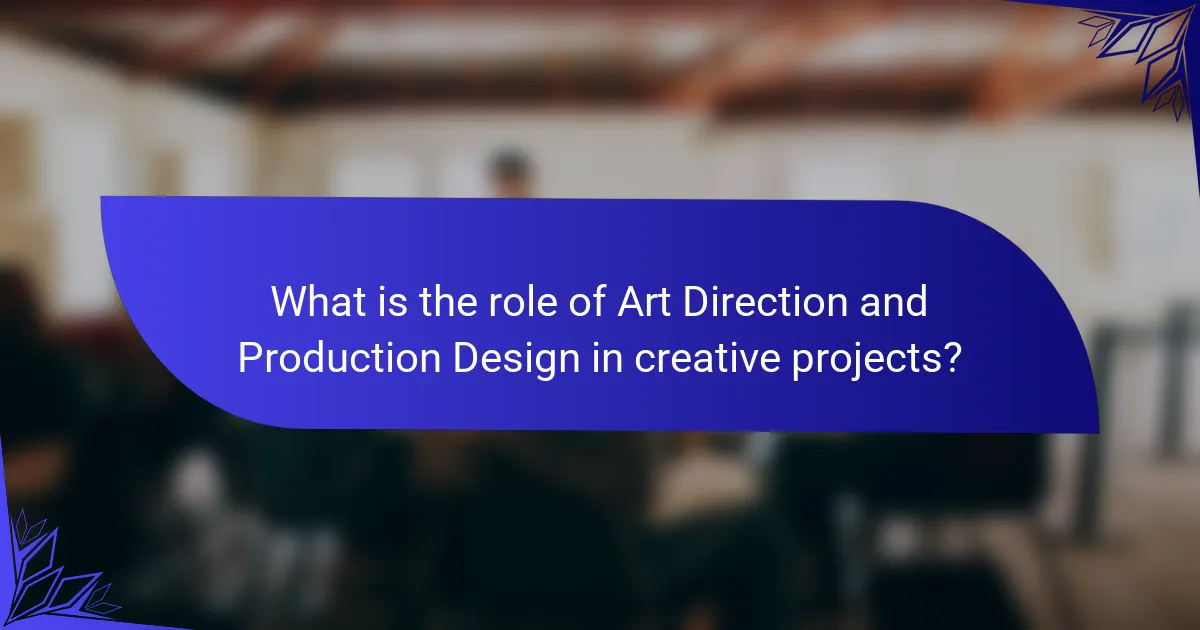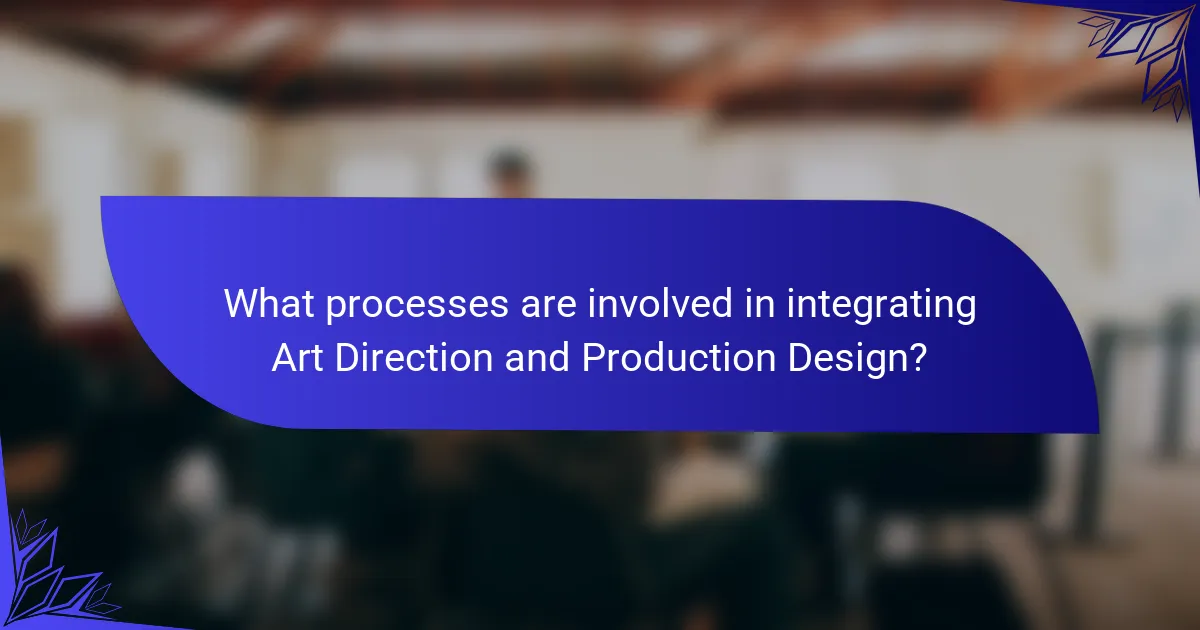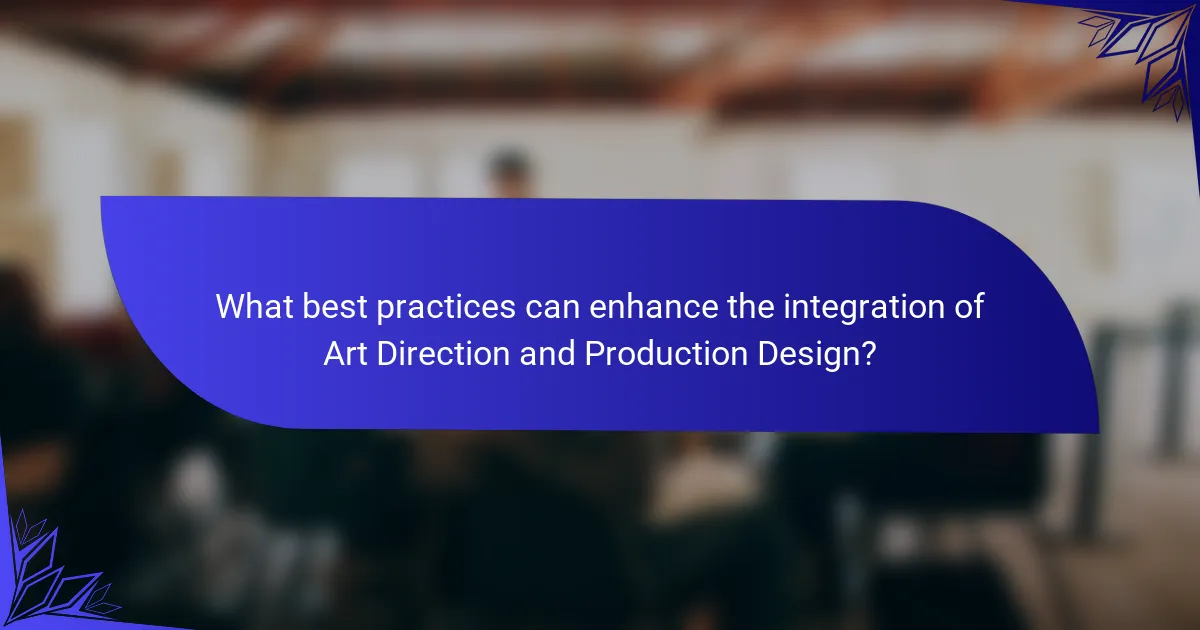Art Direction and Production Design are essential components in the visual narrative of creative projects. Art Direction focuses on establishing the visual style and mood, while Production Design creates the physical environments that support the story. This article outlines the integration of these two roles, emphasizing the importance of collaboration, clear communication, and a cohesive workflow. Key processes include establishing a unified vision, developing a comprehensive design plan, and maintaining feedback loops to adapt to production needs. Successful examples highlight how effective collaboration enhances storytelling and audience engagement in projects like “Blade Runner” and “Mad Max: Fury Road.”

What is the role of Art Direction and Production Design in creative projects?
Art Direction and Production Design are crucial in shaping the visual narrative of creative projects. Art Direction focuses on the overall visual style and mood, guiding the aesthetic vision. Production Design involves creating the physical environments and settings that support the narrative. Together, they ensure that visual elements align with the project’s themes and objectives.
Art Directors collaborate with directors and other creatives to establish a coherent visual language. They make decisions about color palettes, textures, and composition. Production Designers translate these concepts into tangible spaces, working on set design, props, and locations. They consider practical aspects like functionality and budget while maintaining artistic integrity.
Successful integration of Art Direction and Production Design enhances storytelling and audience engagement. Historical examples include films like “Blade Runner,” where visual design significantly impacts the narrative. In summary, both roles are essential for creating immersive and compelling visual experiences in creative projects.
How do Art Direction and Production Design differ from each other?
Art direction and production design are distinct yet interconnected roles in visual storytelling. Art direction focuses on the overall visual style and aesthetic of a project. It involves creating concepts for visuals, including color palettes, typography, and imagery. Production design, on the other hand, deals with the physical environment of a production. This includes designing sets, selecting locations, and overseeing the construction of physical spaces.
Art directors often work closely with graphic designers and illustrators to achieve a cohesive look. Production designers collaborate with directors and cinematographers to create immersive settings that enhance storytelling. Both roles require an understanding of visual composition, but their responsibilities differ significantly. Art direction emphasizes conceptual vision, while production design emphasizes practical implementation.
What are the key responsibilities of an Art Director?
An Art Director is responsible for overseeing the visual aspects of a project. This includes creating the overall design concept and ensuring it aligns with the project’s vision. Art Directors collaborate with other creative professionals, such as graphic designers and photographers. They guide the artistic team in executing designs that meet quality standards. Art Directors also manage budgets and timelines for artistic projects. They are involved in presenting ideas to clients and stakeholders. Additionally, Art Directors stay updated on industry trends to inform their creative decisions. Their leadership ensures a cohesive visual identity across all project elements.
What are the key responsibilities of a Production Designer?
A Production Designer is responsible for the visual concept of a film, television show, or theater production. They create the overall look and feel of the project. This includes designing sets, selecting locations, and overseeing the construction of sets. Production Designers collaborate closely with the director and cinematographer. They ensure that the visual elements align with the story’s themes and mood. Additionally, they manage the art department and coordinate with other departments. Their work includes sourcing props, materials, and color palettes. Ultimately, Production Designers play a crucial role in bringing the script to life visually.
Why is collaboration between Art Direction and Production Design essential?
Collaboration between Art Direction and Production Design is essential for cohesive visual storytelling. Art Direction focuses on the overall aesthetic and visual style. Production Design deals with the physical environment and settings. Both roles must align to create a unified look. When they work together, they ensure that designs are feasible and visually appealing. This collaboration enhances the narrative and emotional impact of the project. For instance, a well-coordinated effort can lead to seamless transitions between scenes. Ultimately, this synergy results in a more immersive experience for the audience.
How can effective communication enhance collaboration?
Effective communication enhances collaboration by ensuring clear understanding among team members. It reduces misunderstandings that can lead to errors. When everyone is on the same page, tasks are completed more efficiently. This fosters a positive working environment. Studies show that effective communication can increase team performance by up to 25%. Regular updates and feedback loops keep everyone informed. This transparency builds trust within the team. Ultimately, strong communication leads to successful project outcomes.
What are the common challenges faced in collaboration?
Common challenges faced in collaboration include communication barriers, differing priorities, and lack of trust. Communication barriers arise when team members do not share the same understanding or terminology. This can lead to misunderstandings and delays in project timelines. Differing priorities often result from individual goals that conflict with team objectives. Such misalignment can hinder progress and create friction among team members. Lack of trust can stem from previous negative experiences or insufficient transparency in decision-making. This can create an environment where team members are reluctant to share ideas or feedback. Addressing these challenges is crucial for effective collaboration and successful project outcomes.

What processes are involved in integrating Art Direction and Production Design?
Integrating Art Direction and Production Design involves several key processes. First, establishing a unified vision is crucial. This vision aligns the aesthetic goals of art direction with the practical requirements of production design. Next, collaboration between art directors and production designers is essential. Regular meetings facilitate communication and ensure that both teams are on the same page.
Additionally, developing a comprehensive design plan is important. This plan outlines the visual and functional elements needed for the project. Resource allocation follows, where materials and budget are determined to support the design vision. Feedback loops are also necessary throughout the process. They allow for adjustments based on production realities and creative input.
Finally, a cohesive workflow is established. This workflow integrates timelines and responsibilities, ensuring that art direction and production design work in harmony. These processes collectively enhance the overall quality of the production.
How does the workflow typically unfold in a project?
A project workflow typically unfolds in distinct phases. It begins with initiation, where project goals and objectives are defined. Next is the planning phase, which involves outlining tasks, timelines, and resources. This is followed by execution, where the project plan is put into action. During execution, teams collaborate to produce deliverables. Monitoring and controlling occur simultaneously to track progress and make adjustments. Finally, the project concludes with closure, where deliverables are finalized and evaluated. Each phase is crucial for ensuring project success and adherence to timelines.
What are the initial steps in the integration process?
The initial steps in the integration process involve establishing communication between art direction and production design teams. This ensures alignment on project vision and goals. Next, a collaborative meeting should be scheduled to discuss creative concepts and design elements. During this meeting, roles and responsibilities must be clearly defined for each team member. Additionally, creating a shared timeline helps synchronize efforts and deadlines. Documenting all discussions and decisions is crucial for future reference. These steps foster a cohesive workflow and enhance collaboration throughout the project.
How are design concepts developed collaboratively?
Design concepts are developed collaboratively through a structured process that involves multiple stakeholders. This process typically includes brainstorming sessions where ideas are shared openly. Team members contribute their unique perspectives and expertise. Feedback loops are established to refine concepts iteratively. Tools such as collaborative software facilitate real-time communication and idea sharing. Visual aids like mood boards or sketches help in aligning the team’s vision. Regular meetings ensure that all voices are heard and integrated into the design. Research shows that collaborative design leads to more innovative outcomes, as diverse inputs enhance creativity.
What tools and techniques facilitate integration?
Collaboration tools and techniques facilitate integration in art direction and production design. Project management software like Trello or Asana helps organize tasks and timelines. Communication platforms such as Slack enable real-time discussions among team members. Digital asset management systems store and share design files efficiently. Techniques like mood boards align creative visions across departments. Regular meetings foster collaboration and address challenges promptly. Feedback loops ensure continuous improvement and alignment on project goals. These tools and techniques enhance workflow and cohesion between art direction and production design teams.
What software is commonly used in Art Direction and Production Design?
Common software used in Art Direction and Production Design includes Adobe Creative Suite, SketchUp, and AutoCAD. Adobe Creative Suite offers tools like Photoshop and Illustrator for graphic design. SketchUp is widely used for 3D modeling and visualization. AutoCAD serves for technical drawings and architectural plans. These tools facilitate collaboration and streamline the design workflow. Their industry adoption supports effective communication among creative teams.
How do mood boards and concept sketches aid in the process?
Mood boards and concept sketches aid in the creative process by visually communicating ideas and concepts. Mood boards consolidate images, colors, and textures that evoke a specific feeling or theme. They serve as a visual reference for the overall aesthetic direction of a project. Concept sketches provide preliminary visualizations of ideas, allowing for quick exploration of design possibilities. They help in refining concepts before detailed work begins. Together, these tools facilitate collaboration among team members. They ensure everyone has a shared understanding of the project vision. This alignment can lead to more cohesive and effective design outcomes.

What best practices can enhance the integration of Art Direction and Production Design?
Effective communication between art directors and production designers enhances their integration. Regular meetings ensure alignment on vision and goals. Collaborative brainstorming sessions foster creativity and shared ideas. Establishing clear roles and responsibilities minimizes overlap and confusion. Utilizing visual references and mood boards aids in conveying concepts. Implementing a shared project management tool streamlines workflow and updates. Feedback loops throughout the production process allow for adjustments and improvements. Documenting decisions and changes maintains clarity and accountability. These practices lead to a cohesive visual outcome, as evidenced by successful projects like “Mad Max: Fury Road,” where collaboration was key to its aesthetic success.
How can teams ensure a smooth workflow?
Teams can ensure a smooth workflow by establishing clear communication channels. Effective communication minimizes misunderstandings and keeps everyone aligned on project goals. Regular check-ins and updates help maintain focus and accountability. Utilizing project management tools can streamline task assignments and deadlines. These tools provide visibility into progress and responsibilities. Setting defined roles and responsibilities reduces overlap and confusion. Encouraging feedback fosters a collaborative environment and continuous improvement. Research shows that teams with structured workflows complete projects 30% faster than those without.
What strategies improve communication among team members?
Effective communication among team members can be improved through several strategies. Regular meetings foster open dialogue and ensure everyone is informed. Utilizing collaboration tools enhances real-time communication and document sharing. Establishing clear roles and responsibilities reduces confusion and aligns expectations. Encouraging feedback creates a culture of openness and continuous improvement. Active listening promotes understanding and reduces miscommunication. Setting communication protocols ensures consistency in interactions. These strategies are supported by research indicating that effective team communication leads to higher productivity and job satisfaction.
How can feedback loops be effectively implemented?
Feedback loops can be effectively implemented by establishing clear communication channels among team members. Regular check-ins should be scheduled to discuss progress and gather input. Utilizing collaborative tools can enhance transparency and streamline feedback collection. Setting specific goals allows for targeted feedback that drives improvement. Encouraging a culture of open dialogue fosters trust and receptiveness to critiques. Documenting feedback ensures it is actionable and can be referenced later. Analyzing feedback trends helps identify areas for continuous improvement. Research shows that organizations with effective feedback loops see a 14.9% increase in productivity (Source: Gallup, “State of the American Workplace”).
What are common pitfalls to avoid in the integration process?
Common pitfalls to avoid in the integration process include lack of communication, unclear roles, and insufficient planning. Poor communication can lead to misunderstandings between art direction and production design teams. Unclear roles may result in duplicated efforts or missed responsibilities. Insufficient planning can cause delays and budget overruns. A study by the Project Management Institute shows that projects with clear communication and defined roles are 30% more likely to succeed. Therefore, addressing these pitfalls is essential for a smooth integration process.
What mistakes often hinder collaboration?
Mistakes that often hinder collaboration include poor communication, lack of clarity in roles, and insufficient trust among team members. Poor communication leads to misunderstandings and misaligned expectations. When team members do not share information effectively, it can result in duplicated efforts or missed deadlines. Lack of clarity in roles creates confusion about responsibilities. This confusion can lead to tasks being overlooked or conflicts over ownership. Insufficient trust among team members can stifle creativity and open dialogue. When individuals do not feel safe sharing ideas, collaboration suffers. A study by the Project Management Institute found that ineffective communication is a leading cause of project failure, highlighting the importance of addressing these mistakes.
How can teams proactively address potential conflicts?
Teams can proactively address potential conflicts by establishing clear communication channels. Regular meetings can facilitate open dialogue among team members. This approach allows for the early identification of issues. Setting clear roles and responsibilities minimizes misunderstandings. Conflict resolution training can equip team members with necessary skills. Utilizing collaboration tools can enhance transparency in workflows. Research shows that teams with strong communication strategies report fewer conflicts. A study by Google found that psychological safety in teams leads to better conflict management.
What tips can help achieve successful integration of Art Direction and Production Design?
Successful integration of Art Direction and Production Design requires clear communication and collaboration. Establish a shared vision early in the project. This ensures both teams are aligned in their goals. Regular meetings facilitate ongoing dialogue about design choices. Utilize visual references to communicate ideas effectively. Define roles and responsibilities to prevent overlap and confusion. Incorporate feedback loops to refine designs iteratively. Use project management tools to track progress and deadlines. These practices enhance teamwork and streamline workflows, leading to a cohesive final product.
The main entity of the article is the integration of Art Direction and Production Design in creative projects. This article outlines the distinct yet interconnected roles of Art Directors and Production Designers, detailing their responsibilities and the importance of collaboration for cohesive visual storytelling. It discusses the processes involved in integrating these roles, effective communication strategies, common challenges, and best practices to enhance workflow. Additionally, it highlights tools and techniques that facilitate collaboration and the importance of feedback loops in achieving successful project outcomes.